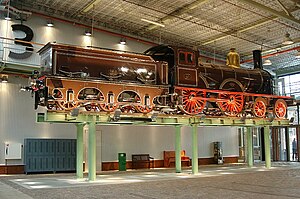
The Hollandsche IJzeren Spoorweg-Maatschappij or HSM was the first railway company in the Netherlands founded on 8 August 1837 as a private company, starting operation in 1839 with a line between Amsterdam and Haarlem. The company remained operational until 1938, when it merged with the Maatschappij tot Exploitatie van Staatsspoorwegen (SS) to form the Nederlandse Spoorwegen (NS).
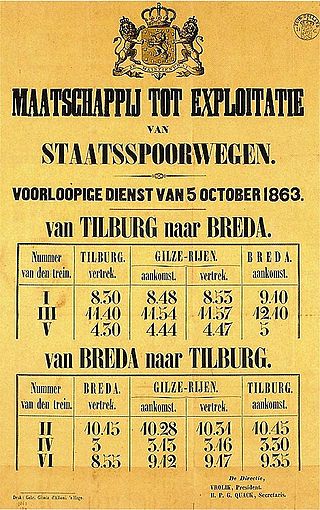
The Maatschappij tot Exploitatie van Staatsspoorwegen or SS was a private railroad founded to use the government funded railways. The company existed until 1938, when it formally merged with the Hollandsche IJzeren Spoorweg-Maatschappij (HSM) to form the Nederlandse Spoorwegen. The SS was, along with the HSM, the largest railroad company in the Netherlands.

The history of rail transport in the Netherlands is generally considered to have begun on September 20, 1839, when the first train, drawn by De Arend, successfully made the 16 km (9.9 mi) trip from Amsterdam to Haarlem. However, the first plan for a railroad in the Netherlands was launched only shortly after the first railroad opened in Britain.

De Arend was one of the two first steam locomotives in the Netherlands. It was a 2-2-2 Patentee type built in England by R. B. Longridge and Company of Bedlington, Northumberland to run on the then standard Dutch track gauge of 1,945 mm. On 20 September 1839, together with the Snelheid, it hauled the first train of the Hollandsche IJzeren Spoorweg-Maatschappij between Amsterdam and Haarlem. It was withdrawn in 1857.
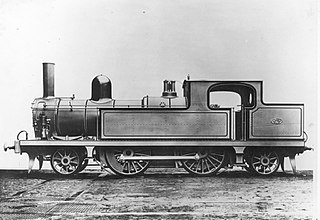
The NS 5300 class were the first of this class in The Netherlands, in fact the NRS employed the first passenger service tender locomotives with this type. The Westinghouse brake system was a first for the NRS; the additional hand brake was common. To obtain a stable ride at high speeds, inside cylinders were employed. The firebox was situated between the coupled axles. The front and rear axles were of the Webb type, already employed by the London North Western Railway. The radial axle boxes were produced with very fine tolerances. Rubber bumpers were employed to move the axle back into position.
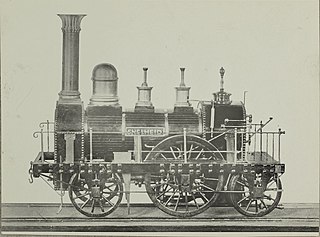
The Snelheid was the name of the first locomotive in the Netherlands, which, together with the Arend, pulled the first train between Amsterdam and Haarlem.

The NS 3400 was a series of goods steam locomotives of the Dutch Railways (NS), ordered by its predecessor the Hollandsche IJzeren Spoorweg-Maatschappij (HSM).

The NS 3300 was a series of goods steam locomotives of the Dutch Railways (NS) and its predecessor Hollandsche IJzeren Spoorweg-Maatschappij (HSM).
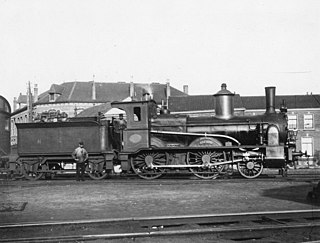
The NS 5600 was a series of steam locomotives of the Dutch Railways (NS) and its predecessors Maatschappij tot Exploitatie van Staatsspoorwegen (SS) and Nederlandsche Centraal-Spoorweg-Maatschappij (NCS).

The NS 1300 was a series of steam locomotives of Nederlandse Spoorwegen and its predecessors Maatschappij tot Exploitatie van Staatsspoorwegen (SS) and Noord-Brabantsch-Duitsche Spoorweg-Maatschappij (NBDS).

The NS 700 was a series of steam locomotives of Nederlandse Spoorwegen (NS) and its predecessors Maatschappij tot Exploitatie van Staatsspoorwegen (SS) and Noord-Brabantsch-Duitsche Spoorweg-Maatschappij (NBDS).

The NS 7600 was a series of tank engines of the Dutch Railways (NS) and its predecessor Hollandsche IJzeren Spoorweg-Maatschappij (HSM) and Haarlem-Zandvoort Spoorweg Maatschappij (HZSM).

The NS 3500 was a series of express train steam locomotives of Nederlandse Spoorwegen (NS) and its predecessors Noord-Brabantsch-Deutsche Spoorweg-Maatschappij (NBDS) and Maatschappij tot Exploitatie van Staatsspoorwegen (SS).
The Nederlandsche Centraal-Spoorweg-Maatschappij (NCS) was founded on 20 February 1860 in Amsterdam and established in Utrecht from 1876 and was dissolved on 23 May 1934. The Central Railway Utrecht – Amersfoort – Zwolle – Kampen was constructed by the NCS.

The NS 3600 was a series of express steam locomotives of the Dutch Railways (NS) and its predecessors Maatschappij tot Exploitatie van Staatsspoorwegen (SS) and Nederlandsche Centraal-Spoorweg-Maatschappij (NCS).

The NS 7100 was a series of tank engines of the Dutch Railways (NS) and its predecessors Maatschappij tot Exploitatie van Staatsspoorwegen (SS), Hollandsche IJzeren Spoorweg-Maatschappij (HSM) and Noord-Friesche Locaalspoorweg-Maatschappij (NFLS).

The NS 7700 was a series of tank engines of the Dutch Railways (NS) and its predecessor the Hollandsche IJzeren Spoorweg-Maatschappij (HSM).

The NS 1900 was a series of express train steam locomotives of the Dutch Railways (NS) and its predecessor Hollandsche IJzeren Spoorweg-Maatschappij (HSM).

The NS 7000 was a series of tank engines of the Dutch Railways (NS) and its predecessors Maatschappij tot Exploitatie van Staatsspoorwegen (SS) and Nederlandsche Centraal-Spoorweg-Maatschappij (NCS).
